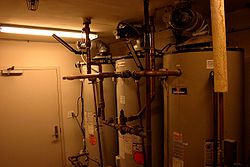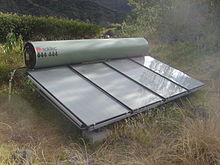Water heating

A water heater or hot water heater is an appliance for heating water above its ambient temperature. In industrial usage, as well when used to heat buildings through steam, large water heaters are called boilers.
Tank heaters
In household and commercial usage, most water heaters are of the tank type. These consist of tanks in which a given amount of water is kept continuously hot and ready for use. Typical sizes for household use are 20 to 50 US gallons (75 to 200 L). These may run on electricity, natural gas, propane, fuel oil, or other energy sources. The most popular in the United States is the natural gas type.
Tank-type water heaters can be made more efficient by installation of additional insulation jackets around the tank, check valve devices at their inlet and outlet, cycle timers, electronic ignition (in the case of fuel-using models), sealed air intake systems (in the case of fuel-using models), and pipe insulation. The sealed air-intake system types are sometimes called "band-joist" intake units. "High efficiency" units can convert up to 98% of the energy in the fuel to heating the water. The exhaust gases of combustion are cool and are mechanically ventilated without the need of a chimney. At high efficiencies a drain must be supplied to handle the water condensed out of the combustion products.
In British English, water heaters are known as boilers, or "Geysers" (pronounced "geezers"), feeding a separate hot water tank. Such tanks are often fitted with a backup electrical heater for a quick boost, known as an immersion heater. It is mandatory that these hot water storage vessels are 'indirect'. That means the water from the boiler circulates via a separate internal exchanger and does not come into contact with the stored hot water. (It is common for first time American users to burn themselves if not warned.)
Water heater safety
Water heaters potentially can explode and cause significant damage to a house if certain safety devices are not installed. When the water temperature exceeds 210 degrees Farenheit, the pressure and increasing heat of the water will cause a violent explosion. A safety device called a TPR valve, temperature pressure relief, is normally fitted on the top of the water heater. The TPR valve senses when the pressure is too great and will discharge water out of the valve. Often a discharge pipe is connected to the valve to direct the flow of water to a drain. Most home inspectors recommend the discharge pipe extend to outside the home so that it does not cause flooding damage. If a water heater is installed in a garage, it is recommended that it be elevated 18 inches off the ground so that the potential for catching fire due to low ground flowing exhaust is eliminated. Some building codes will allow for the discharge pipe to terminate in the garage.
For older homes where the water heater was centrally located, some plumbers will install a Watts 210 device which is installed in place of the TPR valve. When the Watts 210 device senses that the temperature reaches 210 degrees, it will shut off the gas and eliminate the heat from water heater tank. In addition, an outside pressure relief valve is required to be installed on one of the cold water hose bibs on the exterior of the house. If the water pressure is too great in the water heater, it will discharge out through the cold water system to the exterior of the house.
In California, state law mandates that all homes sold, whether new or old, have water heaters strapped and securely bolted to wall studs to prevent the tank from toppling over in a serious earthquake.
Tankless heaters
Tankless water heaters, also called instantaneous, inline or instant-on water heaters, are also available and gaining in popularity. These water heaters heat the water as the water flows through the device, and do not retain any water internally except for what is in the pipe. Tankless heaters may be installed in at faucet or bathroom that is far from the central water heater or larger models can be used to provide hot water for the entire house.
Tankless heaters can be far more efficient than storage water heaters. In both kinds of installation, the absence of a tank saves energy as conventional water heaters have to reheat the water in the tank as it cools off. With a central water heater of any type, water is wasted waiting for water to heat up because of the cold water in the pipes between the faucet and the water heater.
Point of use tankless water heaters are located right where the water is being used, so the water is almost instantly hot, which saves water. They also save even more energy than centrally installed tankless water heaters because there is not any hot water being left in the pipes after the water is shut off. However, point of use tankless water heaters are usually used in combination with a central water heater, as the expense of buying a heater for every kitchen, laundry room, bathroom or sink, often outweighs the money saved in water and energy bills. In addition, point of use water heaters are almost always electrical, and electricity is far more expensive than propane and natural gas.
The most cost effective configuration is usually to use a central tankless water heater for the most of the house, preferably natural gas, and install a point of use tankless water heater at any distant faucets or bathrooms. However, this may vary according to how much electricity, gas and water costs in the area, the layout of the house and how much hot water is used. Only electric tankless water heaters were available at first and they are still used for almost all point of use heaters, but natural gas and propane heaters are now common.
Since the water must be heated instantly, the tankless water heaters use a lot of electricity or fuel while they are on. If a storage water heater is being replaced with a tankless one, the size of the electrical wire or gas pipeline may have to be increased to handle the load.
Solar heaters

In some locales, solar water heaters are used. These are installed outside dwellings, typically on the roof or nearby, and consist of a tank and of a panel in which water circulates. The tank and the panel are painted a dark color in order to maximize the reception of solar heat.
See also
External links
- Tankless Water Heater Interior Components
- Directory of Water Heater Contractors
- Howstuffworks "How Water Heaters Work"
- Water Heater Articles Collection of articles about industrial water heaters
- American Home Inspector Directory
- Water Heating for Dairies - Issues relating to farm dairy water heating
